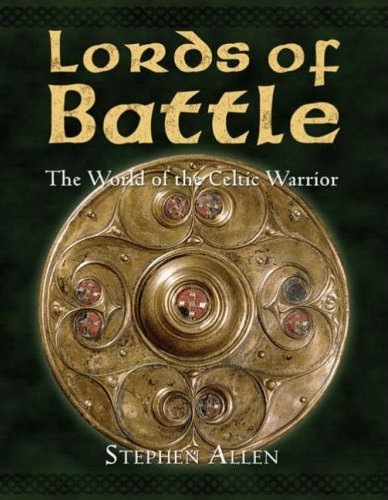
De Re Militari | Book Reviews
Stephen Allen
Lords of Battle: Infamous Medieval Mercenaries
Oxford: Osprey Publishing, 2007. 224pp. ISBN-10: 1841769487 ISBN-13: 978-1841769486. US$29.95.

Stephen Allen’s Lords of Battle is an excellent read on the elusive subject of who the identity of the Celts, thoroughly exploring current and past historical data and presenting a clear and well thought-out picture of Celtic culture. Allen opens by presenting the “old” definitions of the Celts, those made by the Roman and Greeks: images of a warrior race; a group without art or culture; a group dedicated to battle in every way. Allen does not simply brush this aside, but points out the flaws in such a viewpoint as well as acknowledging that in many ways the Celts truly were a warfare-based society.
The first major problem Allen tackles is the definition of “Celt”. Definitions based on geography and ethnicity are quickly discarded as flawed by Allen, who promotes the idea that the only real possible definition of the Celtic race is one of language, be it either the continental or insular dialects of Celtic. Thus throughout the book Allen defines his Celts by their language, instead of using geographical terms.
Chapter one covers the beginnings of the Celtic race, including the Urnfield and Halstatt periods. Allen carefully weaves in the early history of the Celts into the overall history of the region, including both the Mediterranean and European histories. He also goes into great detail concerning the funeral rites and traditions of these early Celts, especially the Vix Princess of the Halstatt. Finally he goes into the decline of the Halstatt and the rise of the La Tène culture, the Celts feared by the Mediterranean world.
Chapter two details the first major push of the La Tène Celts into the Italian Peninsula, including the famous defeat of Rome at the hands of the Celtic leader Brennus, cementing their image in the Roman mind as the terror gallicus, the terrible barbarians from the north. Allen here draws extensively on Greek and Roman primary sources, some of which detail the method of Celtic battle formations and Celtic battle tactics. This chapter also goes into detail concerning the Celtic invasion of the Balkans region and the westward migrations of the Celtic people.
The following chapter discusses the culture and living status of the Celtic people as reported in such primary sources as Polybius, Caesar, and Poseidonius. Allen delves into deep detail on all aspects of Celtic life, accompanying each page with excellent photos and illustrations of grave sites and archaeological finds. Thus, using both textual and artifactual primary sources, he paints a clear picture of the world of the Celts, going beyond the original image of Celts as simply savage barbarian warriors.
Chapter four grapples with one of the most elusive aspects of Celtic culture, their religion. Allen again offers copious detail on the subject, pulling from archaeological evidence, historical accounts, and literary descriptions to give a detailed image of Celtic religion, including the class known as Druids. (Readers here will need to suspend their modern-day knowledge of the groups who take over Stonehenge each solstice day) readers will be engrossed in detail concerning Celtic practices of sacrificing to the gods, the worship of Cernnunos, and what he calls “the cult of the severed head”.
The next section discusses the customs, dress, and armaments of the Celtic warrior, using the archaeological record to give an excellent image of the Celtic fighter. Sources from Livy and Diodorus Siculus explain the battle customs of the Celts and helps justify the famed Celtic prowess on the battlefield. The psychology of warfare is also examined, especially regarding the tendency of Celtic warriors to fight for themselves instead of as a cohesive unit, and the negative effects on morale that “supernatural” events such as a crow flying over a chieftain could have on the Celtic host. The tactics of the Celts are also discussed, using excepts from Caesar’s Gallic Wars and Xenophon’s Hellenica, describing their use of “feigned flight” horsemanship and deployment of battle chariots.
Three chapters of Lords of Battle chronicle the military movements of the Celts in a number of regions. Here we learn of the Celtiberians, Celts who had migrated into the Iberian Peninsula, the Lusitanian War, and the fierce resistance of the Iberian Celts to Roman occupation. Another on the final resistance of the Celts in Gaul, including Caesar’s great conquest of Gaul makes the revolt of Vercingetorix central, as well as the great siege of the Celtic town Alèsia, and its eventual fall to Caesar’s legions. This marked the end of true Celtic dominance in continental Europe, leaving only the British Isles as a final outpost. Chapter eight details that final outpost, discussing Caesar’s thrusts into Britain, the revolt of Boudica and her destruction of Londinium. Allen’s writings on Boudica’s rebellion are supplemented by two major sources, Tacitus’ Annals and Cassius Dio’s Roman History, both adding an excellent illustration to the story of the warrior queen. Finally Allen discusses the Roman commander Agricola, who eventually subdued the Celtic tribes of Britain and fenced in the northern Celts with a line of heavy Roman garrisons.
The last few chapters of Allen’s book detail the final twilight of the independent Celtic race, including the building of Hadrian’s Wall and the eventual integration of the remaining Celtic people into the increasingly Romanized world. Allen closes with an investigation of how the Celts are viewed by modern culture, separating the reality from the romantic images, and the return of Celtic heroes as national French, Belgian, and Spanish heroes.
Overall Stephen Allen’s book is a superb resource for information regarding the Celtic race from their earliest beginnings to their final end. The book is well written and draws the reader in with excellent flow and pace, eloquently telling the story of the Celts while carefully setting primary sources against modern archaeological evidence to paint a detailed and accurate picture.
